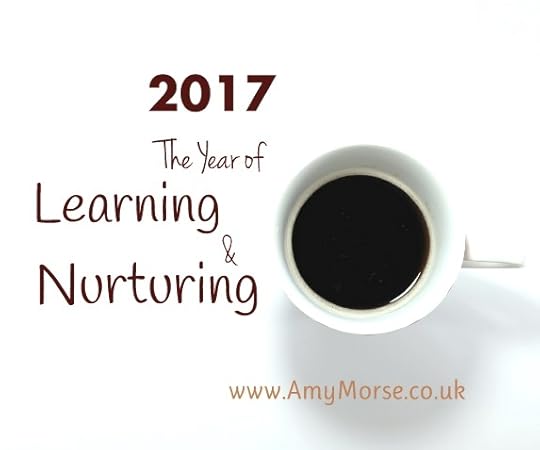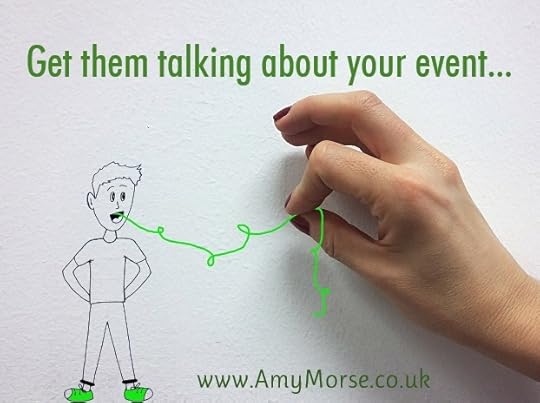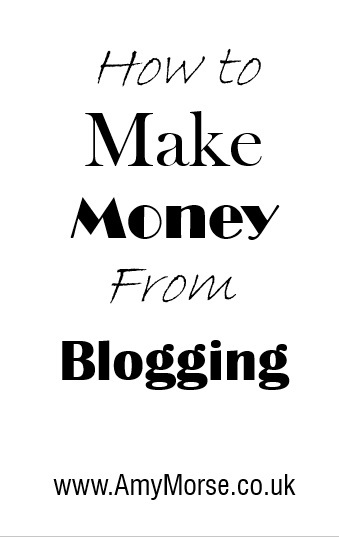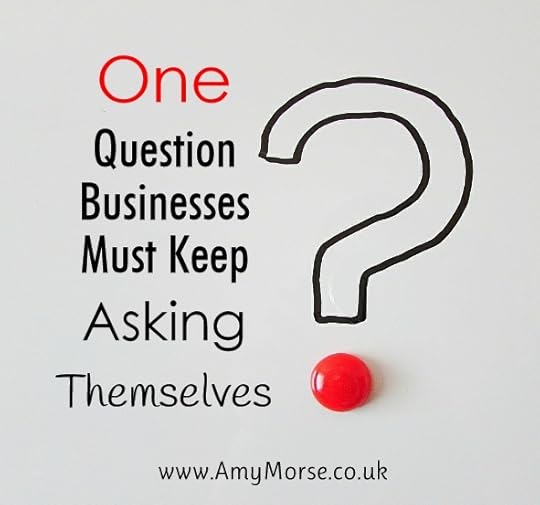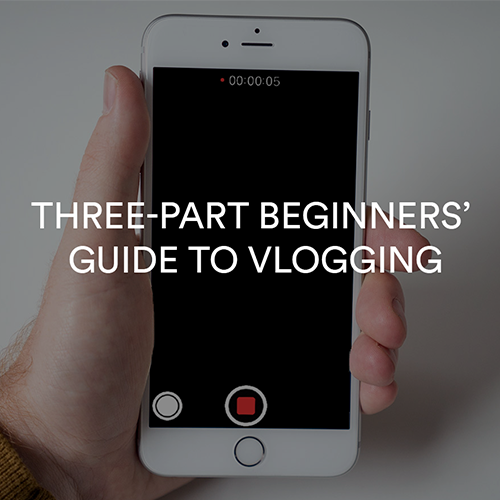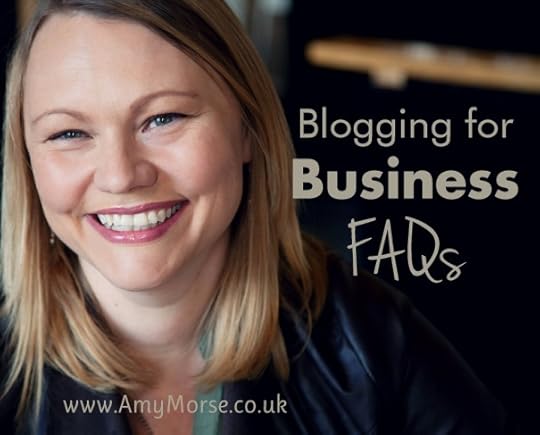Amy C. Fitzjohn's Blog, page 32
January 12, 2017
Something to Declare?
When you get off a flight into the UK, between passport control and the exit you are faced with three possible exits:
The Green Door
The Blue Door (I wonder what colour they’ll paint the blue door after Brexit? Maybe it will be symbolically padlocked shut?)
and The Red Door
Reminds me of a song…
(Turn up your speakers and listen while you read, I guarantee toe-tapping!)
I wonder if anyone ever goes through the Red Door (Goods to Declare), to be greeted with the snap of rubber gloves?
January is the time of year to declare yourself.
The time of year to stop at the red door (I promise, no cavity searches or rubber gloves), take a breath and proceed with courage.
What do you have to declare? Which path will you take in 2017?We don’t know what the future holds. Sorry, there is no crystal ball behind the red door, just a long white corridor into the unknown.
The best we can do is know our hearts and what we want from the future, put that pin on the map and set course for positive change (baby step, by baby step).
I declare 2017 my year of learning and nurturing and here are my goals:
Read a business book each quarter Earn a living from the business (many small steps throughout the year to make this one happen!) Plan my meals and look after myself – fuel my mind and body wellI had a great session with Ann Hobbs at the start of the week and created a ‘vision board’.
Simple and fun.
There were a few of us, assembled in Ann’s living room (being fed delicious home made cake!), then Ann took us through some guided meditation to clear our heads before the fun bit started. We had big bits of paper, stacks of magazines, pens, glue and scissors.
I spent a while going through magazines – drawn to travel, health and business magazines – words, phrases, and images jumped out at me and I chopped away, creating a little pile of cuttings to sort through.
My approach was to divide the board into four areas:
1) Relationships
2) Lifestyle
3) Work / Business
4) Wellness
I then sorted through my cuttings and put them in the appropriate sections.
I spent so long doing this we ran out of time. I took my cuttings home, added to them, and stuck it all down later that afternoon in the seclusion of my dining room, some peaceful music playing.
This is what I produced:
It’s now blue-tacked to the wall behind my desk as a visual reminder of what I want from life and what I’m working for.
Who doesn’t love some crafting and daydreaming on a dreary January day! Thanks, Ann!
For instant updates when I publish a new blog post, Follow me on Bloglovin’
For extra goodies and exclusive new information, join my mailing list HERE. I only send a newsletter monthly so I won’t spam you, I promise!
If you enjoy my blogs, buy me a coffee to say thanks. Donate to my ‘Coffee Kitty’ here (£2.50 / $3 will get me a cappuccino). Thank you 
Save
Save
Save
December 20, 2016
A New Way to Publicise Your Event
Publicising events can be a real struggle. There’s nothing more disheartening than pouring time, effort, and cash, into an event and it being poorly attended.
For a small event, it’s difficult to ‘sell the news element’ which makes it unlikely you’ll attract the interest of traditional media (unless you live in a place where not much happens and it’s a big deal for someone to run a workshop, give a talk or launch a book).
So, who else can you get to report on your event?
…Bloggers!The rise of the ‘citizen reporter’ means that influential bloggers can be as notable, if not more so in the right circles, than getting the local newspaper involved.
According to a ‘Digital Information World’ report, 61% of consumers have made a purchase as a result of reading a blog, and 82% of consumers enjoy reading blogs about their favourite brands.
Blogs are everywhere. We often read them without realising they are blogs – Whenever you click on that Facebook video or Twitter link, the chances are you’re clicking on a blog. Essentially, think of bloggers as the writers and editors of their own on-line magazines.
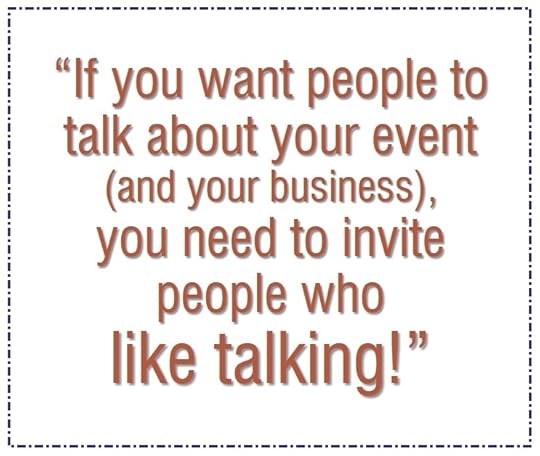 They will have their own subscribers, their own circulation and rather than the relying on the randomness of reaching to wide local audience – like local media – if the audience of the blog is similar to yours, there’s a good chance they’ll share the same traits as your target customers. Bloggers reporting on your event speak directly to the people most likely to be interested in what you offer.
They will have their own subscribers, their own circulation and rather than the relying on the randomness of reaching to wide local audience – like local media – if the audience of the blog is similar to yours, there’s a good chance they’ll share the same traits as your target customers. Bloggers reporting on your event speak directly to the people most likely to be interested in what you offer.
I was on the receiving end of such an offer at the start of December. I was invited to a blogger event at the Apres Bar pop-up bar in Millenium Square in Bristol, by event promotion specialist Pure Co.
Plenty of mulled wine was supplied by Apres Bar (and gratefully received, it was a chilly evening).
Pizza was supplied by the awesome and quirky Pizza Bike.
Entertainment by the hugely talented Just Shut Up And Dance.
Mulled wine, pizza and music make’s for a happy Amy! (What can I say, I’m a cheap date!)
I’m now very happy to go around telling everyone, and retweeting and sharing updates.
My 2,700 Twitter followers are small fry compared to some of the other bloggers who were there, but it all adds up – Apres Bar is getting talked about thanks to that one event.
If you want people to talk about your event (and your business), you need to invite people who like talking!
Here are my top tips to make connections with bloggers so your events get talked about:
Are there people in your existing circle of contacts that blog? Using your existing network will always be more effective than trying to attract random newbies. Be targeted. For example, there’s no point asking a beauty blogger to attend your book launch event (unless it’s a beauty book!) and vice versa – you need to reach out to the right audiences. If you blog yourself (always recommended) – get to know other bloggers by joining communities online, and in the real world. Go to blogger meet ups and build up a contacts book. Put a call out on Twitter for bloggers with # BloggersWanted Exchanging blogs with contacts – by hosting each other as guests – is a great way to build relationships and reach out to each other’s readers. Post your event information in blogger communities. Have a segmented or separate email newsletter lists for blogging contacts and send them personal invitations.
When you invite bloggers to your event, the aim is not to get them to pay to come along as any other delegate; the goal is to work alongside them to build buzz and momentum around the event – get them Tweeting, Instagramming and Facebooking before, during and after the event. Invite them for free, ply them with food and drink, in exchange for sharing the event widely in their networks.
Give it a try and tell me how you get on… I may even blog about it!
For more top tips on how to promote your event – you can download my FREE ‘Event Promotions Printable Checklist’ HERE: Download the Event Promotions Printable Checklist (If you found this downloadable useful, please consider a ‘pay as you feel’ donation via PayPal. Thank you)
May your events be full and fruitful!
And my final word…
Have a Lovely Christmas, and a Happy and Successful New Year!
Save
Save
Save
Save
Save
Save
Save
Save
Save
Save
Save
November 30, 2016
How I Make Blogging Pay (without promoting other brands)
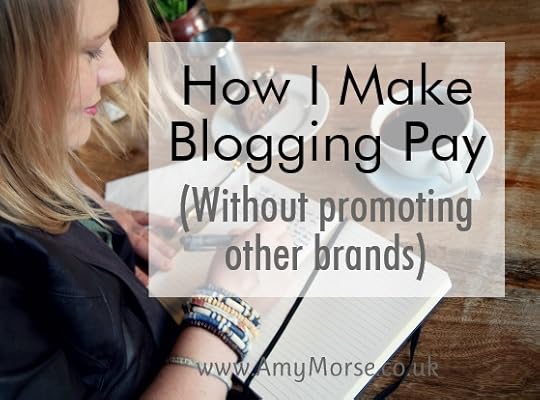 As a writer, the single most enjoyable element of my marketing is blogging.
As a writer, the single most enjoyable element of my marketing is blogging.
Blogging is at the heart of the story of my business.
I first started blogging back in 2013 when I did a 365-day project ‘Operation Author: 365 Actions to Become an Author.’
I completed one action a day for a year and blogged about my seven actions weekly. The most momentous of those actions was to publish my first book, The Bronze Box.
For me, blogging was a way to get social proof for my ideas and writing, to declare my intentions and hold myself accountable in a public space, build an audience and build a business around my words.
The greatest benefits I’ve had from blogging have been to improve my writer’s craft – I blogged about that HERE – but also to generate income.
There are many ways you can potentially generate revenue from your blog:
Advertising (i.e.: GoogleAdSense) Sponsored posts (i.e.: IZEA, BloggersRequired) Product reviews Sell content (i.e.: charge people to download a document) PayPal ‘donate’ Membership fee to access content Affiliate links (i.e.: Amazon affiliate.) Driving traffic Repurposed content ie: eBook sales, workshops, talks, online courses etc.Some, such as advertising, encourage you to promote another brand on your website in exchange for money. More often than not, your website becomes so cluttered with adverts it is unusable and the revenue generated is tiny.
Product reviews can be another way of generating income. There’s a whole community of ‘mummy bloggers’ who review brands and get to keep products (which they can then eBay on) and are paid to write reviews and sponsored posts. This can work well if your business is built around such brands and products.
To build your blog in of itself into a business, as with anything, you need a solid plan. For most of us, however, and certainly the businesses I support, your blog is a way to build your own brand (not everyone else’s).
Sell Content and Membership Fees
The basic concept is to offer something of value that can be downloaded as a file/document and charge people for access to it. The difficulty with this approach is that you will need to invest in a professionally built eCommernce enabled website and decide if this is a worthwhile investment. Alternatively, you could use another platform, for example ‘Expertise.tv’.
You could also offer downloadable content and have an ‘honesty box’ or ‘pay as you feel’ option by asking people to donate via PayPal in exchange for the download, of course, the risk is they will just download it and not pay but is that a risk worth taking? I also include a PayPal Donate button on most of my blogs, you never know, someone may be grateful enough for your content that they share the love and donate a few quid to the kitty!
Affiliate Links
Essentially, you can direct people to another organisation’s ‘shop’ and get a kick back for referring them.
If there are products and services that you know your customers would benefit from, this is a great way of building it into your service. The link to ‘Expertise.tv’ is an affiliate link. Expertise.tv is a webinar platform I use and if someone links to it from my affiliate link and then subscribes, I get some money back (it’s only a couple of quid, but hey, ‘look after the pennies’ and all that!).
I also use Amazon affiliate links. I publish my books through Amazon and if someone buys one of my books through one of the links on my website, I get a small commission back (again, only a few pence!)
You can scatter affiliate links into your existing content seamlessly, and although you won’t make much money from it, it’s better than nothing so you might as well use them!
While these are all small things you can do – unless you intend to build a whole business around an eCommerce site, membership site or product blog – the way most businesses make money through blogging is by ‘Driving Traffic’ to their website and converting visitors into customers and by ‘Repurposing Content’.
Driving Traffic
There are two main ways a blog brings people to your website:
1) Blogging is the single biggest thing you can do to boost SEO (Search Engine Optimisation), in other words, getting to the top of Google. It keeps your website active and stuffed with those all important cross links and keywords.
2) Blogging gives people a reason to come into your online shop and hang around for a while. And as shoppers, we know, the longer we hang around a shop browsing at interesting things the more likely we are to buy something.
Repurposing Content
Information has value. If you blog regularly, over time you will build up a library of content and this can add value to your business.
I wrote a blog on ’16 Ways to Repurpose Your Content’ earlier in the year.
My most lucrative ways to make money this way are:
Running workshops for small businesses. I run regular workshops for Brave Enterprise Agency, among others, and the basis of the workshop materials has come from blog content I’ve written and repurposed into workshop slides and handouts.
eBook Sales. My ‘Blogging for Business’ book developed from a collection of blog posts I expanded on and built into a book
Webinars and Online Courses. This is my next project, I’ve already run some free webinars to get used to the technology and as I build up the videos I can turn them into instruction videos for online courses. I can create downloadables, checklists, printables and eBooks from my blog content and bring it together into online learning tools.
How do you make your blogs earn their keep and make income for your business?Save
Follow me on Bloglovin’If you enjoy my blogs, say thank you by topping up the coffee kitty. £2.50 / $3 will get me a cappuccino. Thanks!


Save
Save
Save
Save
Save
Save
Save
Save
Save
Save
Save
Save
Save
November 18, 2016
One Thing To Love About Networking Events
(This is a short update. It will take less than 5 minutes to read and contains some questions to make networking more productive)
Anyone who’s met me will know I’m a chatter.
On the face of it, I come across as your classic extrovert. I love public speaking, I love facilitating groups, I feed on the positive, motivating energy of the people around me. I’m on my A-game and it’s awesome!
Anyone who knows me sees my public face of incessant, effervescent energy most of the time and might be perturbed if they encounter me out of context and I seem standoffish or strangely quiet.
Anyone who knows me fairly well knows that quiet equals troubled, but might not realise that quiet also means I’m in introvert mode. If I had a pound for the number of concerned looks I’ve had from colleagues and hand-on-shoulder ‘What’s up Aims?’ questions, well, I’d have a few quid – nothing to get too excited about – but a few quid nonetheless!
Anyone who really knows me is aware that my part time extroversion and my part time introversion is just the weirdo, creative, slightly insane contradiction I am! Well done for sticking around, you brave person you!
My default setting might be your typical extrovert, but sometimes, I really just can’t be bothered to be sociable. It’s nothing personal, it usually means I’ve run out of sociable steam and I’m recharging my batteries, in a corner somewhere, quietly minding my own business, nose in a book or just talking to one person and ignoring everyone else!
Those are the times I’ll avoid networking; because those are the times I find it a struggle to muster the big-smile, natter-natter, me!
When I am in extrovert mode, those are the times I love networking events, I’m in my element.
The one thing I love about networking is this…
Permission to walk into a room full of strangers and randomly talk to anyone you like!
How good is that? Everyone is there to connect to people (and you’re less likely to be dragged away by a bouncer, or sneered at for making a nuisance of yourself!)
Conversely, walking into a room full of strangers, although filled with potential, can also be overwhelming.
I wrote a blog last year on 22 Ways to Harness the Power of Networking.
The usual approach at an event is to go up to someone, introduce yourself and ask “what do you do?”
It can get a bit repetitive so here are some alternative questions you could open a conversation with:
What do you enjoy most about what you do? What types of customers do you work with? What have you been working on this week? Are you working with any interesting customers this week?You can also use these questions to keep the conversation going, but a great follow up question to ask once you’re in a conversation with someone is:
What can I do to help you?Or
What are the challenges in your business at the moment?Networking always works best if you go in with the mindset that you just want to help others (and not necessarily for pay! i.e. connect them with other contacts, or offer some ‘free advice / tips’ there and then.)
Once you become a regular at networking events, you want to build a reputation as that helpful person, that friendly person, that generous person – not as the jerk who tries to sell stuff to everyone!
What networking meetings are you going to soon, and would you recommend any? Follow me on Bloglovin’
If you enjoy my blogs, say thank you by topping up the coffee kitty. £2.50 / $3 will get me a cappuccino. Thanks!


Save
Save
Save
Save
Save
Save
Save
Save
Save
Save
Save
Save
Save
November 11, 2016
One Question Businesses Must Keep Asking Themselves
I woke up this morning, lay in bed a for a few minutes just visualising and reflecting on my day, and a question popped into my head – one I realised I’m not asking myself enough:
What will you do to make money today?Having been employed all my life, with self-employment only ever being a part time hustle until last year, it occurred to me that this is a question I’ve never even considered before.
You get used to turning up to work every day, doing what’s expected of you and getting paid at the end of the month. And let’s be honest, many of those days are unproductive, days where you get into work, are bombarded with all manner of distractions, achieve nothing and go home!
If you have days like that in your business, invariably, they’re unpaid!
The fact I’ve never asked myself this question until today is, frankly, ridiculous, considering I’ve been fully self-employed for almost 18 months!
Sure, I’ve asked: ‘how will this business make money?’ – then I’ve been hung up on plans, goals, strategies, long-term vision, helping people, meeting people, raising awareness saying yes to anything that vaguely smells like an opportunity…
Liking saying yes to a last minute call to be on TV yesterday (watch me on Made In Bristol TV HERE)
And saying yes to my business buddy, Hils Crisp, when she proposed a joint workshop for women in business struggling to pay themselves a sensible wage (ironic, I suppose!).
There are only 6 places on the workshop ‘Price Yourself Properly’ on 23rd November and the early bird price ends this weekend, so get in there, or pass it on, quickly:
No doubt, there will be people reading this, who’ve been self-employed for a while, sniggering – it’s obvious, right?
Conversely, I hope it resonates with at least a few others who don’t ask themselves this enough or, like me, have never been so direct with themselves!
 This is such an important question, I’ve stuck it on a post-it note on my monitor as a constant visual reminder!
This is such an important question, I’ve stuck it on a post-it note on my monitor as a constant visual reminder!
Today, I will make money by finishing the editing for my new 4 in 1 bumper eBook boxset and publishing it on Amazon.
(Read about the project on my Amy C Fitzjohn Author blog HERE)
So what will you do today to make money?
Tell us about your latest plans and projects…
Follow me on Bloglovin’ If you enjoy my updates, top up the coffee kitty to say thank you.
If you enjoy my updates, top up the coffee kitty to say thank you.
£2.50 / $3 will get me a cappuccino.
Save
Save
Save
Save
November 4, 2016
The Storyteller’s Secret: Book Review and Tips
I was chatting to a business colleague at an event recently over a coffee and she said something that really resonated, she told me she was much more likely to take notice of someone in business who had published a book. She said, that while blogs and articles are a great resource for finding out information, she is far more likely to trust the authenticity of that information if it comes from a book.
There’s something about our relationship with information and money that makes us far more likely to have faith in something we’ve paid for.
Building a book into your business is a great way to stamp your mark. To be able to walk tall, telling people you are a published author, gives you a new level of credibility as a businessperson.
If this is something on your radar and you’d appreciate a free, no-obligation chat about it BOOK A SLOT HERE
One tip, if you are embarking on a book for your business, tell a story.
I don’t mean share your entire life story in your book, I mean weave in relevant threads of it throughout the narrative to bring your advice and expertise to life on the page. Put it into a relatable context and scatter a little writer’s razzle-dazzle into your book!
If you are writing fiction, telling a story is a given, but in non-fiction, especially business books, it’s easy to forget this fundamental part of human interaction. As a species, we communicate through story.
I’m reading another business book at the moment ‘Rapid Results Referrals by Roy Sheppard’ and while the alliterative title appeals to me, the cover is ugly and the way it’s written is painfully dreary and littered with jargon. The content, however, is valuable and there are a few tiny snippets of humanity in it, but not nearly enough to make it a satisfying and enjoyable read – I shall persevere!
A book I have read recently, that is both satisfying and motivating is ‘The Storyteller’s Secret’ by Carmine Gallo.
Each chapter tells the story of a successful entrepreneur and reveals how they each used the power of stories to find that success. Crammed with tips and backed up with academic research, it’s a brilliant resource for any business leader who wants to communicate well on a human level.
A powerful story can both inspire and educate.
Author, Maya Angelou, is famously quoted as saying:
“People will forget what you said, people will forget what you did, but people will never forget how you made them feel.”
Unless you can elicit an emotional response from a reader (make them laugh, make them cry, make them empathise), they’ll forget you.
Each chapter ends with a ‘Storyteller’s Tools’ section offering a bite-sized chunk of practical advice and rounds of with a ‘Storyteller’s Secret’ – the single most powerful storytelling lesson that worked for them.
My only criticism of this book is it is a little repetitive but with each chapter a story in itself you can dip in and out of different chapters out of sequence.
Stories are at the heart of everything I do. If I’m not making up intricate stories in my hyperactive imagination for my fiction novels, I’m enthusing and empowering people to embrace their stories and tell them well in their own words to benefit their business.
My three takeaways, influenced by this book, are:
There’s a 60/40 rule when presenting information: 60% story, enriched with 40% stats and facts.
Be succinct, use few, well-chosen words and use simple words to explain complex concepts
The power of three: break the story into three parts and stick to three core points.
If you like what you’ve read, say thank you by topping up the coffee kitty here. £2.50 /$3 will get me a cappucinno, Thanks


Save
Save
Save
Save
October 28, 2016
Social Management Tools for Start-ups – Guest Blog & Infographic
I’ve had a flurry of guest blog submissions recently and it gives me great pleasure to host another one on the blog this week.
Highly regarded on the world speaker circuit, Lilach Bullock has graced Forbes and Number 10 Downing Street with her presence! In a nutshell, she’s a hugely connected and highly influential serial entrepreneur – the embodiment of Digital Intelligence. Read more about Lilach after the post, needless to say, I’m delighted to host her here.
This topic is one that resonates with me. Personally, I use HootSuite and it has revolutionised my approach to social media management. It’s simple and intuitive and allows me to dedicate a couple of short chunks of time to planning social media each week, without it taking over my life!
Lilach shares some great tips and information about this and other platforms. Although this is aimed at start-ups, there are also plenty of useful tips for more established businesses who are still getting to grips with their social marketing. Enjoy…
Social Media Management Tools for Start-ups
As a start-up, you need all the help you can get to help you make sure you get the most out of your social media marketing efforts and be as productive and efficient as possible. Social media can be very time-consuming, especially when you are just starting up as a business, but with a good social media management tool assisting you, you can make your job just a little bit easier.
G2Crowd and Ian Anderson Gray of the Seriously Social blog have partnered up to create an infographic that rates the top 5 social media management tools of 2016 based on customer reviews. In this post, I will be talking about some of these tools and how they can help you get more out of your social media as a start up.
How social media management tools can help a start-upA good social media management tool can be of huge assistance, for several reasons:
Save time and become more efficient: social media management tools are huge time-savers, particularly as you start growing and you get more engagement and mentions and to keep up with more social profiles to manage. Having all of the tools you need in one place means you don’t have to log in and out of several accounts, as you have everything you need on a single dashboard – from posting and scheduling updates, to monitoring conversations and looking for engagement opportunities. Monitoring: with most social media management tools, you can monitor multiple keywords and accounts so you only know if anyone is mentioning your business online, but even more importantly for start-ups, monitoring keywords can help you find engagement opportunities on social media. Create monitoring streams for keywords related to your business and check them regularly to see what people are saying. You might find some questions that you can answer, people talking about subjects that you can join in and potential followers that are relevant to your business. Posting and scheduling social updates: with most social media management tools (at least the ones I’ll be looking at), you can post and schedule updates from the same place. Scheduling updates is especially useful as a start-up because in most cases, there simply aren’t enough resources to make sure that you’re posting updates as often as you should. When every member of your team has multiple duties that they need to get through, scheduling updates can help you save some precious time while also making sure you reach followers when you otherwise wouldn’t be able to. Team collaboration: this is a great feature for start-ups, as it makes it easier to share some of the social media marketing with other team members and employees. Many start-ups find it easier and more productive to have several members of the team pitch in and with some tools you can even check any update, etc. before they can be posted. Analytics: there are lots of great social media analytics tools on the market, with many of them free. However, with a social media management tool you can get all of your relevant analytics and even better, in some cases you can download them into PowerPoints or PDFs, which is great if you have to show your results to any investors. Customer relationship management: More and more social media management tools are incorporating CRM features. This is useful as it’s important to see what kind of followers you have and discover potential brand ambassadors and influencers that can help you grow your online brand. So, what tool should I get?There are so many different tools out there that it can get quite difficult to find the best one or rather, the best one for your business. Here is a rundown of the top 5 rated tools on the market and the results from the infographic:
 Infographic brought to you by Seriously Social and G2 Crowd
Infographic brought to you by Seriously Social and G2 Crowd
More about Lilach
 Listed in Forbes as one of the top 20 women social media power influencers and likewise as one of the top social media power influencers, she is one of the most dynamic personalities in the social media market and was crowned the Social Influencer of Europe by Oracle. Recently listed as the number one Digital Marketing Influencer in the UK by Career Experts. She is also a recipient for a Global Women Champions Award (by the Global Connections for Women Foundation, GC4W) for her outstanding contribution and leadership in business.
Listed in Forbes as one of the top 20 women social media power influencers and likewise as one of the top social media power influencers, she is one of the most dynamic personalities in the social media market and was crowned the Social Influencer of Europe by Oracle. Recently listed as the number one Digital Marketing Influencer in the UK by Career Experts. She is also a recipient for a Global Women Champions Award (by the Global Connections for Women Foundation, GC4W) for her outstanding contribution and leadership in business.
After launching her first business within three years of becoming a mother, her financial success was recognised by being a finalist at the Best MumPreneur of the Year Awards, presented at 10 Downing Street. Following a resultant offer and wishing to spend more time with her daughter, she sold her first business to focus on social media, developing a multi-site blog and online marketing portfolio that generated in excess of 600,000 + visitors per month.
Lilach is consulted by journalists and regularly quoted in newspapers, business publications and marketing magazines (including Forbes, The Telegraph, Wired, Prima Magazine, The Sunday Times, The Guardian, Social Media Today and BBC Radio). What’s more, her books have achieved No 1 on Amazon for Sales and Marketing and Small Business and Entrepreneurship.
When Lilach isn’t working she enjoys spending time with her family and is an avid fan of Zumba.
A big thank you to Lilach for contributing.
Save
Follow Amy on Bloglovin’If you enjoy my blogs, say thank you by topping up the coffee kitty. £2.50 / $3 will get me a cappuccino. Thanks!

Save
Save
Save
Save
Save
Save
Save
Save
Save
Save
Save
October 20, 2016
Three Part Beginners’ guide to Vlogging – A Guest Post
This week, I’m proud to host another guest on the blog.
I met Hannah Squires, of Doubleshot, at a recent workshop ‘Blogging for Business’ that I ran on behalf of Brand 51.
I always offer delegates at my events the opportunity to showcase their business on the blog.
During the workshop, the group discussed the power of great imagery on an effective blog post and touched on the growing popularity of Vlogs (Video Blogging).
As a video editor and social media marketer for a Bristol-based video production company, Doubleshot, Hannah has some great insights to share.
A big thank you to Hannah for contributing
Three-part beginners’ guide to vloggingYou’ve probably noticed that video is dominating our social channels, it’s everywhere you look! …and while video adverts can seem expensive and out of reach for most small businesses, vlogging is a wonderfully inexpensive way to market yourself using video.
Please don’t start to panic! You don’t need to be a video expert to start vlogging, as long as you have something worthwhile to say you can use video to drive your business forward and create a dynamic and memorable profile at the same time. If you don’t know the first thing about vlogging, but you know you want to start, here is some advice.
Content
When crafting your content think about simple and innovative ways to convey information whilst entertaining your viewers. Play to your strengths, be resourceful and find your own authenticity.
Perhaps you could record day to day activities in your office, invite your audience into your company’s brainstorming sessions, or maximise on your team talents by getting them to talk about their specialist subject? You can vlog about almost anything, just make sure it’s valuable to your viewers.
Know what you want to say but not how you are going to say it? Have an idea or a question in mind that you are going to answer, but don’t write out every sentence word by word. If you plan everything you are going to say it will come across unnatural and you will lose those small characteristics that make us all unique and relatable. The beauty of video is that you can re-record your vlog as many times as you like and then rearrange what you say in the edit, so don’t worry about getting it perfect the first time.
Try and keep your vlogs upbeat by injecting a little humour into them. This will help you build a stronger relationship with your viewers… and don’t forget to smile! A genuine smile will relax yourself and everyone watching.
Equipment
Filming equipment doesn’t have to be as expensive as you think. These days you can make a good video on your phone. If you are thinking of filming more often, you might want to invest in a good camera or even just the latest iPhone. People won’t expect the editing of your vlogs to be of ‘blockbuster’ quality either. Basic cutting can be done on your smartphone or on YouTube for free.
The main rule is to make sure that the space is well lit, and that the audio is clear. This doesn’t mean you need to go out and buy the latest microphone and studio lights. Position yourself so you are facing a window, or flick on a couple of lamps. If you can take a good selfie, you can light a good video.
Make sure you pick a room that is far away from any noise pollution. Things like kettles and running water. If the room seems a little echoey, throw a few cushions around. Soft furnishings will help keep your audio sounding clear and professional.
Consistency
Consistency is an important factor when vlogging, be consistent about when and how often you are going to post a new vlog. If you only have time to vlog once a month that’s fine, if you want to vlog every week, great! – but make sure you stick to it.
Unfortunately, we have very short attention spans, so keep your vlogs short, around 30 seconds or less. If you have more to say, we recommend using the vlog to recap your points and then posting a full copy article in a link below. 96% of consumers will click links after watching videos, so if they enjoyed your vlog it’s very likely they will click your link as well. Also, this will drive traffic to your website, which is the whole point of vlogging in the first place! So win win!
Every business big or small can benefit from vlogging. I know it seems scary at first, but the more you do it the more comfortable you will feel. If you want to know more tips for vlogging, or you need some video marketing advice you can contact me at hannah@doubleshot.tv, always happy to give advice.
Happy vlogging!
——————————————————————————-
Hannah Squires is the video editor and social media marketer for a Bristol-based video production company, Doubleshot. Doubleshot create effective online videos for businesses from tech start-ups to luxury brands. You can find out more at www.doubleshot.tv.
For more inspiration, advice and tips on creating an effective blog to build your business get my ‘Blogging for Business‘ book here:
eBook
Paperback
Follow Amy on Bloglovin’If you enjoy my blogs, say thank you by topping up the coffee kitty. £2.50 / $3 will get me a cappuccino. Thanks!


Save
Save
Save
Save
Save
Save
Save
Save
Save
Save
Save
Save
Save
Save
Save
Save
October 15, 2016
Blogging for Business FAQs
I regularly work with people who are getting to grips with building an effective blog into their business. Whether it’s at one of my regular ‘Blogging for Business’ workshops or 1:1.
Having a blog on your website gives visitors to your virtual shop a reason to step inside and hang around. The more people browse, the more likely they are to buy something.
This is just one of the many benefits of blogging as an integral part of your content marketing strategy.
Download more HERE (Free PDF)For me, as a writer and someone who helps other businesses to be better writers, it’s essential – my blogs are the beating heart of the story of my business.
I’m frequently asked the same questions about blogging – Tell me which of them you have by voting on this poll:
surveys & pollsI’ll be answering these and more questions at my first ever live webinar on 19th October at 2pm.
Book you place HERE (even if you can’t make the live event, I will then send you the recording)
An increasing number of individuals and businesses are turning to eLearning to tackle their skills challenges.
According to Education Sector Factbook, eLearning is expected to grow by an average of 23% into 2017.
With my growing library of blog content, workshops, eBooks and downloadables, taking this knowledge into online workshops seems like the natural next step for my business.
The biggest barrier for me is the technology.
I’m showing my age here, but when I was at school, computers were only just being introduced.
We  had a room with 5 or 6 BBC Micro computers, all running DOS, and we were a school that was a pioneer in bringing technology into education!
had a room with 5 or 6 BBC Micro computers, all running DOS, and we were a school that was a pioneer in bringing technology into education!
My first ‘proper’ job was at the VAT office, and as the youngster, I was given one of the few PC’s in the office and told to learn this new fangled ‘Windows’ technology.
My first ‘laptop’ was bigger than a desktop power unit today and weighed about 3Kilos.
 Our first computer at home was a Commodore Vic 20 with games on cassette tapes.
Our first computer at home was a Commodore Vic 20 with games on cassette tapes.
In many ways, I’ve grown up as technology has evolved, but it changes so fast, it can be tough to keep up.
Just as I’ve got used to using tools like ‘WordPress’, the next mind-boggling advancement in software comes along.
I happened upon a Facebook ad for ‘Expertise.tv’ and investigated further.
With ‘Expertise.tv’ there is a free forever webinar package. The free package is fairly limited in that you can’t record your webinars or monetize them, but you can host as many free webinars as you like to unlimited numbers of people. In my case, it presented me with a risk-free option to test it out.
 With my ‘Blogging for Business’ book available on Amazon, and with my plans to create eLearning packages around the topic of blogging, a blogging Q&A seemed like the obvious subject to tackle for my first live webinar. Wish me luck!
With my ‘Blogging for Business’ book available on Amazon, and with my plans to create eLearning packages around the topic of blogging, a blogging Q&A seemed like the obvious subject to tackle for my first live webinar. Wish me luck!
Book your place on the ‘Blogging for Business Q&A’ webinar HERE. It’d be great to see you there!
Get the ‘Blogging for Business’ book HERE
(Disclaimer: I have included affiliate links to ‘Expertise.tv’ – I was going to write about it anyway so I joined their affiliate scheme. So far, Expertise.tv has been an intuitive and simple to use tool, but ask me again next week after my first webinar!) Follow me on Bloglovin’
If you enjoy my blogs, say thank you by topping up the coffee kitty. £2.50 /$3 will get me a cappuccino – Thanks!

Save
Save
Save
Save
Save
Save
Save
Save
Save
Save
October 6, 2016
How to Reach Out to Readers After You Self-Publish – A Guest Post
(This post will take less than10 minutes to read)
Today, I’m proud to host another guest blog by a fellow wordsmith.
This is a topic close to my heart, but it will also be useful to anyone who’s published a book as part of their business, or have published a novel and need some pointers.
I made a conscious business decision to go the self-publishing route with the Sheridan and Blake Adventure Series. I blogged about it HERE.
If self-publishing is an option you are considering, it’s a worthwhile read.
Cassie is a tech and entertainment blogger who is interested in self-publishing and social media and how they are changing the publishing culture for the better.
A massive thank you to Cassie for a great overview to those new to the concept of having an ‘Author Platform’ and what their next steps should be to raise awareness of their books.
How to Reach Out to Readers After You Self-PublishHaving your work published by a large publishing house is not easy. For many years, authors simply wrote for their own satisfaction because nobody would publish their work. This is finally changing with the advent of self-publishing and its acceptance as a legitimate option for authors.
Thanks to self-publishing, authors have more freedom today than they had in the past. There are countless excellent self-published books on the market.
Authors may be nervous about self-publishing for a variety of reasons, especially the fear of having to market their books themselves. They believe that large publishing houses handle all the marketing for authors, but this is not the case. While they do some marketing and promotion for their authors, the bulk of the work still lies with the author. Whether a large publishing house publishes your book or you self-publish, you have to do most of the promotion and marketing yourself.
There are many ways to promote and market your work, but one of the most effective is to reach out to your readers. This is true for both self-published and traditionally published authors. If you want your readers to read more of your work, you need to keep in contact with them. Despite the time and effort it takes, it’s worth doing. Here are a few good ways to do this.
Construct an Author Platform
If you are going to reach out to your readers, you need to have a “home base” from which to work. This is where your author platform comes in.
While there isn’t a simple definition for an author platform, it is really just a way for you to promote your work and keep in contact with your readers. It keeps a channel of communication open between you and your readers. Many readers want to contact their favourite authors, and an author platform will allow them to do that. Just remember it’s a difficult task, but it is vital to your success.
There are a few different methods to build your author platform. The most successful methods are creating your own website and starting a blog with a comments section. The comments section will help you keep in contact with your readers.
It’s useful to register your name and the name of your work as domain names. Registering domain names will allow you to create websites you can use as your author platform. However, if you don’t have the funds to do so, you can always create your blog on one of the free blogging services that are readily available. Later, when you do have enough money, you can register domain names.
Once you’ve created your website or started a free blog, you need to spend some time safeguarding yourself and your work. You will most likely be posting some personal information on your author platform, and there are lots of unscrupulous people who are only too happy to exploit this by harassing you or stealing your personal information. This is why it is critical you use a reputable Virtual Private Network, such as Buffered VPN.
You should also use reliable anti-virus software with a firewall, such as a McAfee product.
Use Your Author Platform Correctly
After you’ve built your author platform, you need to use it to reach out to your readers. The first thing you need to do is to include links to all the retailers selling your book. This will allow your readers to purchase any of your work with ease. After all, you don’t want to make it difficult for them to buy your books.
Your author platform also needs content, so you should write a bio page with a little information about yourself. Once you’ve done that, you can start blogging. Obviously, you need to write about your work, but remember your readers want to get to know you as well as your work. So reach out to them by including a few pieces that will show them who you are as a person.
You don’t have to include very personal information, just the sort of thing you would share with an acquaintance.
Novelty keeps people interested, so don’t post the same information over and over. Your readers will get bored and stop following you.
The comments section of your website or blog is the perfect way for you to connect with your readers. Encourage them to leave comments and respond to them in a meaningful way.
Don’t bother responding to trolls though. It will only encourage them to continue harassing you.
Allow Social Media to Work for You
Most people belong to at least one social networking website. You can use these social networking sites to reach out to your readers.
Start by joining as many social networking sites as you can realistically manage. Don’t forget the popular ones, such as Facebook, Google+, LinkedIn, Twitter and Goodreads.
Create profiles and pages for each of them, and remember to include a link to your website or blog on each profile or page.
Put links to all of your social networking pages on your website or blog.
Just as you do with your website or blog, post pieces that will interest readers. Then get involved.
Respond to comments in a meaningful way to allow readers to get to know you and encourage them to communicate with you. You’ll build a rapport that will enhance your success as an author.
As a self-published author, how do you reach out to your readers? How do you engage them? Let us know in the comments.
Thanks Cassie!
Find out more about her work and her books at her website: www.culturecoverage.com
Connect on Twitter: @cassie_culture
Save
Save
Save
Save
Save
Save
Save
Save
Save


